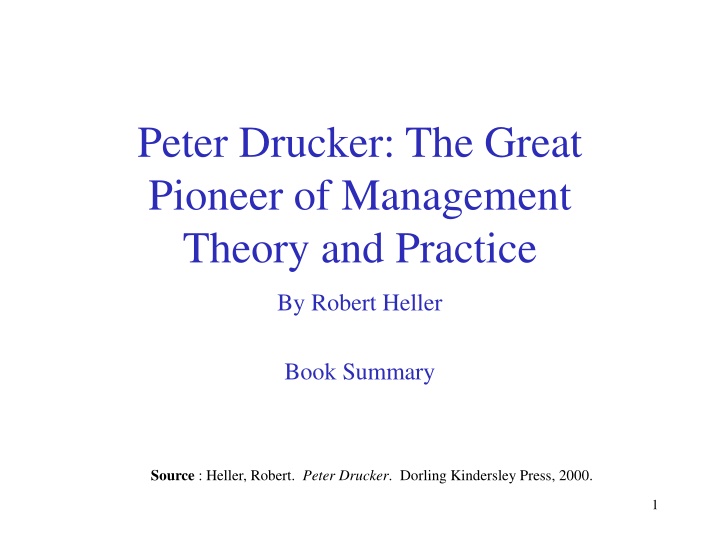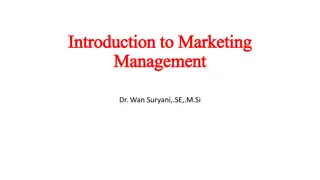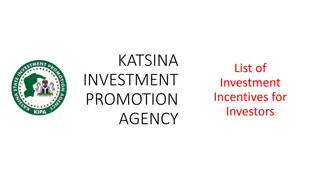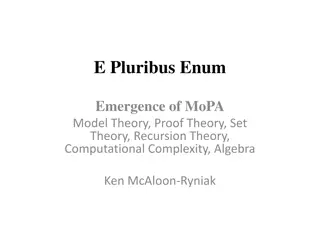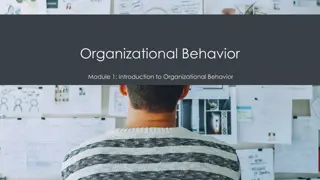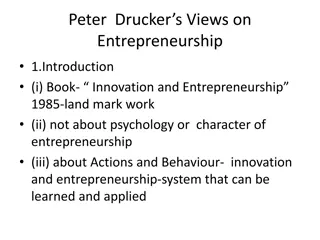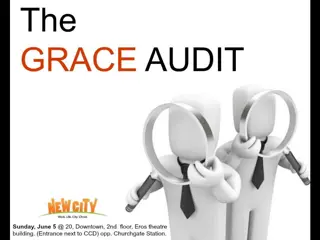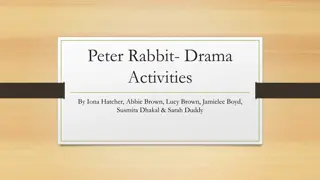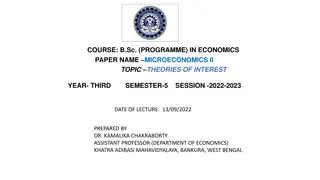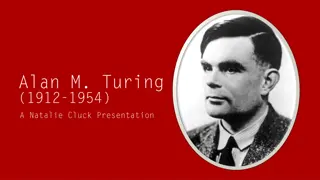Peter Drucker: The Great Pioneer of Management Theory
Peter Drucker was a pioneer in management theory and practice, emphasizing the importance of maintaining a valid theory of business, adapting to change, and putting ideas into action. This book summary by Robert Heller explores Drucker's insights on organizing for success in business, the validity of business theories, preventive measures for theory maintenance, and danger signs indicating obsolescence. Drucker's ideas continue to be relevant for organizations striving for success in a dynamic environment.
Download Presentation

Please find below an Image/Link to download the presentation.
The content on the website is provided AS IS for your information and personal use only. It may not be sold, licensed, or shared on other websites without obtaining consent from the author.If you encounter any issues during the download, it is possible that the publisher has removed the file from their server.
You are allowed to download the files provided on this website for personal or commercial use, subject to the condition that they are used lawfully. All files are the property of their respective owners.
The content on the website is provided AS IS for your information and personal use only. It may not be sold, licensed, or shared on other websites without obtaining consent from the author.
E N D
Presentation Transcript
Peter Drucker: The Great Pioneer of Management Theory and Practice By Robert Heller Book Summary Source : Heller, Robert. Peter Drucker. Dorling Kindersley Press, 2000. 1
Organizing for Success in Business Every organization has a theory of business - - assumptions on which the organization has been built and run upon. Source : Heller, Robert. Peter Drucker. Dorling Kindersley Press, 2000. 2
Organizing for Success in Business What Makes a Theory of Business Valid Assumptions about the environment, mission, and core competencies must fit reality. Assumptions in all three areas have to fit one another. Theory must be known and understood throughout the organization. Theory has to be tested constantly and altered if necessary. Source : Heller, Robert. Peter Drucker. Dorling Kindersley Press, 2000. 3
Organizing for Success in Business Maintaining a Valid Theory of Business: Preventive Measures Abandonment - Challenging every three years every product, service, distribution channel with the question, If we were not in it already, would we be going into it now? Studying what goes on outside the business, especially non-customers. Source : Heller, Robert. Peter Drucker. Dorling Kindersley Press, 2000. 4
Organizing for Success in Business Maintaining a Valid Theory of Business: Danger Signs A theory of business always becomes obsolete when an organization attains its original objectives. Any organization that doubles or triples its size within a fairly short period of time has necessarily outgrown its theory. Source : Heller, Robert. Peter Drucker. Dorling Kindersley Press, 2000. 5
Organizing for Success in Business Signals that a Theory is No Longer Valid Unexpected success - whether one s own or a competitor s Unexpected failure - whether one s own or a competitor s Source : Heller, Robert. Peter Drucker. Dorling Kindersley Press, 2000. 6
Organizing for Success in Business Ideas into Action Spend all the time you need on making decisions that affect people. Makes sure that everybody understands what your business is really about. Study what is going on outside the business, and among customers and non-customers. If the business is growing fast, question your assumptions again. Look out for and learn from unexpected success your own and others . Do exactly the same with unexpected failure, especially your own. Source : Heller, Robert. Peter Drucker. Dorling Kindersley Press, 2000. 7
The Art of Management in Practice Management is about human beings. Its task is to make people capable of joint performance, to make their strengths effective and their weaknesses irrelevant. - Peter Drucker, The New Realities Source : Heller, Robert. Peter Drucker. Dorling Kindersley Press, 2000. 8
The Art of Management in Practice What A Manager Does Sets objectives Organizes Motivates & communicates Establishes measurement tools Develops people, including him- or herself Source : Heller, Robert. Peter Drucker. Dorling Kindersley Press, 2000. 9
The Art of Management in Practice Effective Self-Management: What managers should ask of themselves What am I doing that does not need to be done at all? What am I doing that can be done by somebody else? What am I doing that only I can do? Source : Heller, Robert. Peter Drucker. Dorling Kindersley Press, 2000. 10
The Art of Management in Practice Effective Self-Management: What workers should ask themselves Who am I? What are my strengths? How do I work? Where do I belong What is my contribution? Source : Heller, Robert. Peter Drucker. Dorling Kindersley Press, 2000. 11
The Art of Management in Practice Executive s Toolkit for Managing the Current Business Foundation information Productivity information Competence information Resource-allocation information Source : Heller, Robert. Peter Drucker. Dorling Kindersley Press, 2000. 12
The Art of Management in Practice Executive s Toolkit : Foundation Information Cashflows, sale, ratios etc. Source : Heller, Robert. Peter Drucker. Dorling Kindersley Press, 2000. 13
The Art of Management in Practice Executive s Toolkit: Productivity Information Productivity of key resources Economic value-added analysis Benchmarking Source : Heller, Robert. Peter Drucker. Dorling Kindersley Press, 2000. 14
The Art of Management in Practice Executive s Toolkit: Competence Information Every organization needs one core competence -- innovation How many opportunities did the organization miss? Why? Because it did not see them? Or because it saw them and dismissed them? Assessment rather than measurement. Source : Heller, Robert. Peter Drucker. Dorling Kindersley Press, 2000. 15
The Art of Management in Practice Executive s Toolkit: Resource-allocation Information What will happen if investments fail to produce the promised results? Would it seriously hurt the company? If investments are successful, especially more so than we expect, what will it commit us to? Source : Heller, Robert. Peter Drucker. Dorling Kindersley Press, 2000. 16
The Art of Management in Practice Ideas into Action Make sure you communicate clearly and often with colleagues, superiors, and subordinates. Do the Feedback Analysis as a matter of course to build on your strengths. Gain really effective control by conducting a comprehensive business audit. Work back to costs from what customers are prepared to pay. Look at several measures of capital employment not just one. Have specific expectations for people s performance and appraise it systematically. Develop business intelligence about actual and potential competitor s worldwide. Source : Heller, Robert. Peter Drucker. Dorling Kindersley Press, 2000. 17
Managing by Objectives & Self-Control A managers job should be based on a task to be performed in order to attain the company s objectives .the manager should be directed and controlled by the objectives of performance rather than by his boss. - Peter Drucker, The Practice of Management Source : Heller, Robert. Peter Drucker. Dorling Kindersley Press, 2000. 18
Managing by Objectives & Self-Control The Integrated Management System The management by objectives (MBO) technique is only one way of seeking to control, coordinate, and motivate managers. Six Stages of MBO 1 Define corporate objectives at board level 2 Analyze management tasks and devise formal job specification, which allocate responsibilities and decisions to individual managers 3 Set performance standards 4 Agree and set specific objectives 5 Align individual targets with corporation objectives 6 Establish a management information system to monitor achievements against objectives. Source : Heller, Robert. Peter Drucker. Dorling Kindersley Press, 2000. 19
Managing by Objectives & Self-Control The Integrated Management System For MBO to be effective, individual managers must understand the specific objectives of their job and how those objectives fit with the overall company objectives set by the board of directors. Source : Heller, Robert. Peter Drucker. Dorling Kindersley Press, 2000. 20
Managing by Objectives & Self-Control Performing in Key Result Areas Key result areas where managers need to pursue clear objectives : Marketing Human organization Financial resources Social responsibility Innovation Productivity Physical resources Profit requirements Source : Heller, Robert. Peter Drucker. Dorling Kindersley Press, 2000. 21
Managing by Objectives & Self-Control Managing for Results Producing results in the market and the economy rests on eight perceptions : Resources and results exist outside, not inside, the business. Results come from exploiting opportunities, not solving problems. For results, resources must go to opportunities, not to problems. Economic results do not go to minor players in a given market, but to leaders. Source : Heller, Robert. Peter Drucker. Dorling Kindersley Press, 2000. 22
Managing by Objectives & Self-Control Managing for Results Producing results in the market and the economy rests on eight perceptions : Leadership, however, is not likely to last. What exists is getting old. What exists is likely to be misallocated (.e., the first 10 percent of effort produces 90 percent of the results). To achieve economic results, concentrate Source : Heller, Robert. Peter Drucker. Dorling Kindersley Press, 2000. 23
Managing by Objectives & Self-Control Individual Responsibility In a knowledge-based organization, management has to ask each employee : What should we hold you accountable for? What information do you need? What information do you owe the rest of us? Source : Heller, Robert. Peter Drucker. Dorling Kindersley Press, 2000. 24
Managing by Objectives & Self-Control The Management Orchestra In the knowledge-based company, the superior cannot as a rule do the work of the supposed subordinate any more than a conductor can play the tuba. Source : Heller, Robert. Peter Drucker. Dorling Kindersley Press, 2000. 25
Managing by Objectives & Self-Control The Management Orchestra What the knowledge workers needs : Challenge, above all To know the organization s mission and to believe in it Continuous training The need to see results Source : Heller, Robert. Peter Drucker. Dorling Kindersley Press, 2000. 26
Managing by Objectives & Self-Control The Management Orchestra What managers should ask themselves regarding an employee : What has she or he done well? What is the person likely to do well? What do they have to learn to be able to get the full benefit from their strength? If I had a son or daughter, would I be willing to have them work under this person? Source : Heller, Robert. Peter Drucker. Dorling Kindersley Press, 2000. 27
Managing by Objectives & Self-Control The Management Orchestra : Managing for Effectiveness Managers should constantly ask themselves : What does the situation require? How could I make my greatest contribution with my strengths, my way of performing, my values, to what needs to be done? What results have to be achieved to make a difference? Source : Heller, Robert. Peter Drucker. Dorling Kindersley Press, 2000. 28
Managing by Objectives & Self-Control Ideas into Action Understand that there is no one right way to manage people. For best results, give resources to opportunities, not to problems. Get to know the organization s mission and to believe in it. Find out what you should do, and how the go ahead and do it. Ask yourself whether you produce results as a decision-maker or an adviser. Help yourself and others to learn how to manage yourselves. Ask yourself what you should do, rather than simply doing what you are told to do. Source : Heller, Robert. Peter Drucker. Dorling Kindersley Press, 2000. 29
Harnessing the Power of Innovation Entrepreneurs need to search purposefully for the sources of innovation, the changes and their symptoms that indicate opportunities for successful innovation. - Peter Drucker, Innovation & Entrepreneurship Source : Heller, Robert. Peter Drucker. Dorling Kindersley Press, 2000. 30
Harnessing the Power of Innovation Searching for Changes : Sources for Entrepreneurial Opportunities The unexpected success, failure, or outside event The incongruity between reality as it actually is and reality as it is assumed to be Innovation based on process need Changes in industry structure or market structure that catch everyone unawares. Source : Heller, Robert. Peter Drucker. Dorling Kindersley Press, 2000. 31
Harnessing the Power of Innovation External Sources of Changes Demographics (population change) Changes in perception, mood, and meaning New knowledge, both scientific and non-scientific Source : Heller, Robert. Peter Drucker. Dorling Kindersley Press, 2000. 32
Harnessing the Power of Innovation Principles of Innovation : The Do s List Analyze the opportunities. Go out to look, to ask, to listen Keep it simple, keep it focused Start small -- try to do one specific thing Aim for market leadership Source : Heller, Robert. Peter Drucker. Dorling Kindersley Press, 2000. 33
Harnessing the Power of Innovation Principles of Innovation : The Do Not s List Don t try to be clever Don t diversify, don t splinter, don t try to do too many things at once. Don t try to innovate for the future Source : Heller, Robert. Peter Drucker. Dorling Kindersley Press, 2000. 34
Harnessing the Power of Innovation Managing Innovation Separately If an entrepreneurial business is placed inside an established management system, it is likely to fail Do not mix managerial units and entrepreneurial ones Steer clear of diversification because it doe not mix with entrepreneurship and innovation Do not try to solve the problem by buying in -- acquiring small entrepreneurial ventures Source : Heller, Robert. Peter Drucker. Dorling Kindersley Press, 2000. 35
Harnessing the Power of Innovation Managing Innovation Separately Not only must the entrepreneurial, the new be organized completely separately from the old and existing , there has to be a special locus for the new venture within the organization, and it has to be pretty high up. Source : Heller, Robert. Peter Drucker. Dorling Kindersley Press, 2000. 36
Harnessing the Power of Innovation Forming the Business X-ray The business X-ray furnishes the information needed to define how much innovation a given business requires, in what areas, and within what time frame. Source : Heller, Robert. Peter Drucker. Dorling Kindersley Press, 2000. 37
Harnessing the Power of Innovation Forming the Business X-ray Questions to ask when developing the business X-ray : How much longer will this product grow? How much longer will it maintain itself in the marketplace? How soon can it be expected to age and decline and how fast? When will it become obsolescent? Source : Heller, Robert. Peter Drucker. Dorling Kindersley Press, 2000. 38
Harnessing the Power of Innovation Managing New Ventures : The Four Requirements A focus on the market Building a top management team long before new the ventures actually needs one and long before it can actually afford one Source : Heller, Robert. Peter Drucker. Dorling Kindersley Press, 2000. 39
Harnessing the Power of Innovation Managing New Ventures : The Four Requirements Financial foresight, especially in planning for cashflow and capital needs. A decision by the founding entrepreneur with respect to his or her own role, area of work, and relationships Source : Heller, Robert. Peter Drucker. Dorling Kindersley Press, 2000. 40
Harnessing the Power of Innovation Entrepreneurial Strategies Being Fastest with the Mostest -- the greatest gamble, aiming from the beginning at permanent leadership Hitting Them Where They Ain t -- either by creative imitation , which surpasses the original innovation; or by entrepreneurial judo , which enables newcomers to catapult themselves into leadership position against the entrenched, established companies. Source : Heller, Robert. Peter Drucker. Dorling Kindersley Press, 2000. 41
Harnessing the Power of Innovation Entrepreneurial Strategies Finding and occupying a specialized ecological niche -- obtaining a practical monopoly in a small area Changing the economic characteristics of a product, a market, or an industry - by creating utility , or pricing, or adaptation to the customer s social and economic reality, or delivering what represents true value to the customers Source : Heller, Robert. Peter Drucker. Dorling Kindersley Press, 2000. 42
Harnessing the Power of Innovation Ideas into Action Maintain a purposeful and organized search for new opportunities. Look for incongruity between reality and what it is assumed to be. Innovate for a present need, not for a future possibility. Give a new venture a senior godfather or godmother to whom it reports. Keep flexible spot what goes wrong and turn error to advantage. Focus on cashflow, capital, and controls not profit Build your team from within, developing its own management skills. Source : Heller, Robert. Peter Drucker. Dorling Kindersley Press, 2000. 43
Responsible Knowledge Management That knowledge has become theresource, rather than a resource is what makes out society post- capitalist. It changes the structure of society. It creates new social dynamics. It creates new economic dynamics. It creates new politics. - Peter Drucker, Post-Capitalist Society Source : Heller, Robert. Peter Drucker. Dorling Kindersley Press, 2000. 44
Responsible Knowledge Management Identifying Future Developments In the West and Japan, retirement age will rise Economic growth can come only from a very sharp continuing increase in the productivity of knowledge work and knowledge workers Source : Heller, Robert. Peter Drucker. Dorling Kindersley Press, 2000. 45
Responsible Knowledge Management Raising Knowledge Productivity A winning strategy will require information about events and conditions outside the institution : non-customers, technologies other than those that are currently used by the company and present competitors, markets not currently served, etc. Source : Heller, Robert. Peter Drucker. Dorling Kindersley Press, 2000. 46
Responsible Knowledge Management Toward the Knowledge Society The real, controlling resource and the absolutely decisive factor of production is now neither capital, nor land, nor labor. It is knowledge. Source : Heller, Robert. Peter Drucker. Dorling Kindersley Press, 2000. 47
Responsible Knowledge Management Ideas into Action Use new measures, such as the balanced scorecard and activity-based costing. Develop rigorous methods for gathering information from outside the company. Employ people for their knowledge and manage them accordingly Don t search for the right model design your own organization. Concentrate on getting good long-term results while summarizing specific objectives. Track the company s performance against a strategic plan and specific objectives. Make managing knowledge a prime concern in managing the business. Source : Heller, Robert. Peter Drucker. Dorling Kindersley Press, 2000. 48
Managing Effectively Masterclass Effectiveness vs. Efficiency : Two Key Questions Managers Must Ask The Functions of a Manager 2 Organizing the group communicating 1 Setting objectives 3 Motivating and 4 Measuring performance 5 Developing people Am I truly doing the right thing (effective)? Or am I merely doing things right (efficient)? Source : Heller, Robert. Peter Drucker. Dorling Kindersley Press, 2000. 49
Managing Effectively Masterclass Effectiveness vs. Efficiency : Two Key Questions Managers Must Ask Effective Efficient Setting Objectives Against each function list the activities you are involved with. Organizing the group For each function, mark yourself out of 10 for effectiveness and efficiency. Motivating and Communicating Measuring Performance Developing People Source : Heller, Robert. Peter Drucker. Dorling Kindersley Press, 2000. 50
